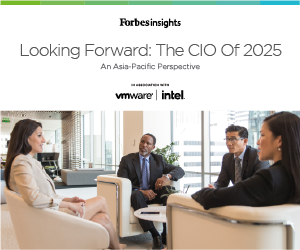BRANDVOICE
Top tech leaders across Asia Pacific believe multi-cloud technology will have the greatest impact on their industry in the year 2025, even ahead of AI and machine learning.
CIOs are prioritising cybersecurity, hybrid work capabilities, and the modernisation of their app platforms in the lead-up to the year 2025.
And they’re leveraging multi-cloud environments to make all the above happen, while also increasingly gaining more responsibility and sway on the strategic direction of their organisations.
That’s according to Looking Forward: The CIO of 2025 Asia-Pacific, a report by Forbes INSIGHTS in association with VMware and Intel, surveying more than 600 leading CIOs globally on their priorities and concerns between now and 2025, as well as how their role is changing.
One in five (20%) CIOs globally believe that next generational cloud and multi-cloud tech will have the greatest impact on their industry in the year 2025 – only behind AI and machine learning (at 29%).
But those CIOs surveyed across APAC are more keenly aware of the influence of multi-cloud tech on the future, with 29% citing it as the number one impact.
Driven by the opportunities created within cloud-smart organisations, most of APAC’s tech executives (81%) are ahead of their international counterparts in leveraging more than one cloud platform. More than one in five use between four and 10 public clouds.
Vice President and Managing Director of VMware Australia and New Zealand, Brad Anderson says organisations that gain the most positive impacts from a multi-cloud environment in 2025 will be those with a clear CIO-led strategy that’s supported and understood by the CEO and board.
“Security, innovation, and scalability are central pillars of business growth in 2023 and this will continue well into the decade. CIOs have significant influence in helping their businesses accelerate in these areas,” says Anderson.
Sixty per cent of CIOs globally say they are already involved in corporate strategy and development, according to the research. And with 64% saying tech issues are now considered more important at the board and executive level, Anderson believes these next few years will see CIOs really come to prominence in business decision making.
Across APAC, the influence of CIOs is already very high and likely having a massive impact on company strategy and direction. For example, CIOs in APAC are nearly twice as likely as their counterparts in the Americas to already sit on their boards (60% versus 32%).
Following a rapid period of change for organisations over the past few years, CIOs are chasing stability – without sacrificing growth and performance – in the lead-up to 2025.
Some of the top reasons CIOs cited for why they are deploying multi-cloud infrastructure included improving security (with 81% citing this as a reason to use it), ensuring business continuing and avoiding outages (77%), and enabling the business to scale more quickly (75%).
Anderson says that unlocking innovation is also crucial for these CIOs, with 64% saying they believe multi-cloud infrastructure will help accelerate innovation.
“We can’t overestimate the appetite for innovation in these next three years. Particularly given the speed of development in artificial intelligence, the increasing expectations of customers, as well as the workflow and collaboration improvements that can and will come from creating more seamless and employee-friendly hybrid work environments,” he says.
On hybrid work, CIOs indicated seeing significantly more potential for such environments, and therefore a top priority for 2025. They are increasingly supporting their business in developing multi-cloud resources to create the best remote work capabilities, essential for attracting in-demand staff.
CIOs also see modernising their applications and app platforms as a critical priority for enabling the business to stay ahead of the competition and for maintaining efficient and lower-cost supply chains in the future. Seventy-two per cent believe CIOs should “take a bold leap forward in developing their application strategies.”
But those CIOs in Asia-Pacific markets see multi-cloud environments and modern apps as more important to innovation, when compared with other regions. More than one third (37%) of these CIOs cite modern applications as a key technology to accelerate innovation and adoption of other technologies, compared to 23% in Europe and 7% in the Americas.


“There is a crucial relationship between multi-cloud and modern apps,” Anderson says. “By using multi-cloud to create their pipelines, CIOs can build, run and manage cloud-native apps at scale. This increases reliability and efficiency, while also reducing cost and time to market.”
Overall, Anderson says the results of the survey highlight the growing power of tech leaders to not only unlock greater efficiencies, growth, and innovation, but to also position their organisation for contending with the confronting business challenges ahead.
“CIOs who can make swift decisions and use a cloud-smart approach to deliver results quickly, will be better positioned to deliver business benefits such as revenue acceleration, faster time-to-market and create the best possible environment to attract great staff.”
Check out the full Forbes INSIGHTS paper from VMware and Intel here.